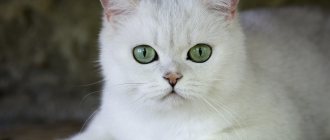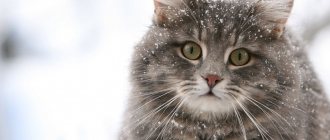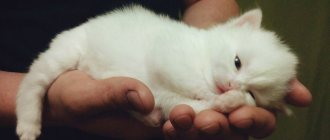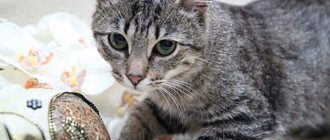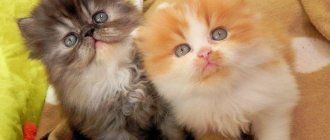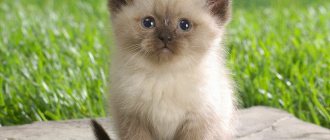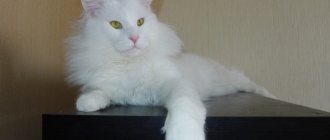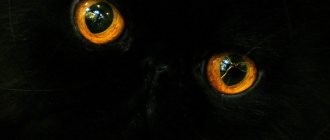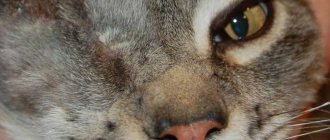Cat colors by type
Abyssinian Point .
A combination of point color and ticking. Agouti . Wild color. With agouti colors, each hair on the cat's body has clearly defined zones - ticking, while the tip of the hair has the color of the main color - typing.
Harlequin . Van color, with additional evenly distributed spots on the body and legs. Intermediate between bicolor and van.
Bicolor (Bi-Colour). Evenly distributed spots of primary color on white.
Van bicolor (Van/Van Bicolour). White color with a colored tail and the same spots on the head between the ears.
Smoky color (Smoke). Single-color version of silver tabbies (typing no more than 1/2 of the total hair length).
color . Silver and golden colors, similar to chinchillas and differing from them in a slightly longer tip length (no more than 1/4 of the total length of hairs). The term "shaded" is also used to refer to this type of color for the red, cream and tortoiseshell variations.
Calico . A combination of tortoiseshell and white without agouti, smoke or silver. The ideal calico color is that spots of different colors should not have common boundaries, but should be separated by white.
Tabby Point . Point color with tabby pattern.
Mitted . White “slippers” on all four paws.
Mink . The body is darker than with the point color, and the tips of the paws and muzzle are even darker.
Weakened color (Dilute). Lightening intense colors of black to blue, chocolate to lilac, red to cream, etc.
Parti-Colour . Tortoiseshell color occupies no more than a third of the body surface.
Pointed . Siamese or Himalayan color - the body is lighter than the paws, tail and ears.
Sepia . Solid color of Burmese cats, an outdated name for the "ivory" color of Siamese cats.
color . Tabby colors are similar to wild colors, but differ from them in the background color (white with a grayish tint, reminiscent of the color of silver).
Solid /Self. The coat color is only one color, without agouti.
Tabby . Groups of cat colors that have a characteristic pattern of stripes and spots on the face, limbs and tail and are classified by the type of pattern on the body.
Ticking . Alternating areas of background (grayish-yellow to bright orange) and base color on each hair of agouti-colored cats. The width of these areas, small at the root, increases towards the tip of the hair. The number of sections is not always the same for different colors and varies from 4 to 7-10.
Tipping . The ends of a cat's fur, usually the same color as its base coat.
Torby . Combination of tortoiseshell and tabby color.
Torbico . A combination of tortoiseshell tabby and white color.
Tri -Colour. Tortoiseshell bicolor; same as calico.
Tortoiseshell color (Tortie). Colors characteristic, as a rule, only of female animals. Alternating patches of black (blue, chocolate, lilac, cinnamon, or fawn) and red (cream) on a cat's coat.
Tortie Point. Point color with tortoiseshell markings.
Chinchilla (Chinchilla). The name of a specific silver and golden color, characterized by an almost complete absence of the usual tabby pattern, a decrease in the size of the main color areas and an increase in the background areas in the ticking, while the typing occupies no more than 1/8 of the total length of the hairs.
More details
The concept of color in cats covers, firstly, the actual color of the cat’s fur, secondly, the pattern of stripes on the fur or its absence, thirdly, the presence or absence of white spots of different sizes on the fur and the order of their location, fourthly, different degrees of wool coloration.
About pigments
The color of a cat's fur, skin and eyes is due to the presence of the pigment melanin . Melanin is found in the hair body in the form of microscopic granules that vary in shape, size and quantity, which causes differences in color. There are two chemical varieties of melanin: eumelanin and phaeomelanin . Eumelanin granules are spherical and absorb almost all light, giving black pigmentation. Pheumelanin granules are oblong (ellipsoidal in shape) and reflect light in the red-yellow-orange range.
Eumelanin is responsible for black color (and its derivatives - chocolate, blue, lilac, fawn, cinnamon), and feumelanin is responsible for red (cream). The genes that are responsible for the appearance of red (O - orange) or black (o - not orange) are located on the X chromosome, that is, the inheritance of color is linked to sex. Cats have two X chromosomes and, accordingly, three color options: OO - red, XX - black, Oo - tortoiseshell (red-black). Cats have one X chromosome and, depending on which gene it carries, O or O, it will be red or black. Tortoiseshell coloring in cats appears only in the case of genetic disorders, and such cats are sterile.
Thus, the inheritance of traits whose genes are located on the X or Y chromosome is called sex-linked. Genes localized on the X chromosome and not having alleles on the Y chromosome are inherited from mother to son, in particular, a red cat cannot be born to a black cat, and vice versa, a red cat cannot give birth to a black series cat.
Color point color
This variation is also called Siamese or Himalayan. The main shade is white, but on the face, ears, tail and paws you can see a mask of a different color. The color is unusual and beautiful. Kittens are born white and darken as they age. The eyes must be sky blue, the paw pads and nose must be the same tone as the color spots.
Allowed variations:
- Seal point - the main background is a warm shade, the markings are dark brown, the color resembles the color of a fur seal;
- Chocolate point (chocolate point) is a rather rare color, the main background is ivory with chocolate spots;
- Blue point – with characteristic markings of a pale blue hue;
- Cream point – color of markings – soft cream;
- Blue cream point - the color of the markings is light blue, which is mixed with cream. Both a gray-blue nose with specks and a pure pink one are allowed;
- Tortie point is a cream tortoiseshell variety with red or dark cream markings;
- Red point – red marks on the main background;
- Lilac point is considered a rare color; the markings are lilac;
- Lynx point – there are many variations in this section, but spots and tabby stripes are scattered throughout the animal’s body; the pattern appears as the cat grows older.
Varieties of Tabby
If your cat has stripes, spots and other pronounced patterns on his body, then most likely his color is “tabby”. The main background may be different, but the paw pads and nose should be pigmented to match. Silver tabbies have a pale background and almost white hair roots. The markings should be well defined and painted in a contrasting color. It is very difficult to breed representatives of the cat family with the correct pattern.
Varieties about:
- Mackerel or tiger tabby - vertical stripes run parallel along the cat's body. Numerous spots or spirals on the sides of the animal are not allowed;
- Marble color is a classic variety. Spots resembling butterflies are randomly scattered on the cat’s body, and three clear stripes run along the ridge. On the chest you can see two narrow stripes resembling a necklace, and on the side there is a spiral. On the forehead there is a characteristic letter M formed by dark stripes, the belly is spotted;
- Spotted - spots of different sizes are scattered throughout the body, sometimes they look like intermittent stripes;
- Ticked tabby or agouti - it is characterized by ticking, that is, the presence of several stripes of different colors. The main background is plain; the cat's back may be slightly darker than the rest of the coat; stripes and spots are not allowed. There is a characteristic rim around the eyes and nose. This color is the hallmark of the Abyssinian breed, but can also be found in other cats;
- Tabby with patches. Two different colors should alternate with each other. A striking example is torbie - a soft color that combines areas of blue and cream. Brown tabby is also common, similar to the leaf color in autumn when red and brown tabby alternate.
Variations allowed:
- Cream (cream tabby) – the main background is cream, with dark markings on it;
- Black (black tabby) – clearly defined black stripes on a golden-brown background;
- Red (red tabby) – on a red main background, a pattern of rich red color;
- Chocolate (chocolate tabby) – on a light main background, a zonal pattern of dark chocolate color;
- Lilac tabby – contrasting dark purple tabby against the main ivory background;
- Blue cream silver tabby – the main tone is light blue, which is mixed with a warm cream color, the undercoat color is white-silver;
- Silver (silver tabby) – on a silver main background there is a contrasting black pattern. Eyes should be green or hazelnut-colored;
- Blue silver tabby – the main background is silver, with a black pattern applied to it;
- Brown (brown tabby) – on a main silver background, a milk chocolate color pattern;
- Cameo (red silver, cameo) – a contrasting red pattern on a silver background.
White color
White color is a complete lack of pigmentation. In cats, solid white fur can be achieved in three different cases:
White albino is a recessive variant that is very rare in cats.
Solid white spots - appear under the influence of the white spot factor (S), which is not completely dominant, is subject to polygenetic modifications and usually leads to the fact that the cat is not entirely white. However, the spots may be so dense that the animal appears completely white. White spots are described in the following sections.
Dominant White - This mutation suppresses all other pigmentation genes, and results in a white coat color and blue eyes. As the name suggests, this is the effect of the dominant white gene (W). In the case of dominant white, the genes for other colors and patterns, although present, are completely hidden. The only way to determine the main genotype in practice (before the appearance, conduct a genetic analysis to determine the genotype of the cat) is by crossing with colored cats of a well-known genotype. Breeding two dominant whites will usually result in all-white kittens, but if both parents are heterozygous (W/w), some kittens may show primary colors. If the genotype of the white parents is not known from the pedigree or test crosses, the mating result is unpredictable.
Dominant white is found in a variety of breeds. Sometimes white Oriental Orientals are considered by some associations as a separate breed. The dominant white color has a much deeper blue eye color than albinos, and this is considered an advantage. The best blue eye color is observed in completely white Oriental Oriental cats that carry a suppressed chocolate gene.
Deafness in cats is associated with the spotting (S) and white dominant (W) genes, but not with the albinism gene (c/c or ca/ca).
Character
In order to understand such an animal, it is enough to imagine how those born with a defect survive in nature. But they survive with great difficulty, and most often do not survive at all. Natural selection in the wild occurs mercilessly, and no one will mess with someone who does not meet the parameters and requirements of the pack.
A white predator will not be able to go hunting and at the same time remain unnoticed by its prey . This means that there is a great certainty that he will have to starve. If an animal that is usually hunted by predators was born snow-white, then it has a greater chance of becoming prey than its relatives. It stands out too much and is noticeable over long distances.
Hence the loss and feeling of inferiority. Animals rejected by their kind are more attached to those who care for them and keep them company, namely people. Now you understand why such unusual kittens born from domestic cats are not recognized as marriages among people and are not destroyed.
They are welcomed by humans as the most affectionate and loyal of cats. And besides, we love the color white. We associate it with purity, evokes tenderness and a desire to show care. But what are we dooming cats to by allowing them to live?
Agouti and non-agouti
The colors of cats are very diverse. Some cats are evenly colored - these are the so-called solid colors or solids . Other cats have a pronounced pattern - in the form of stripes, circles. This pattern is called tabby . Tabby "opens" on the coat thanks to the dominant gene A - agouti. This gene colors each cat's hair with evenly alternating dark and light transverse stripes.
In dark stripes, a larger amount of eumelanin pigment is concentrated, in light ones - less, and the pigment granules elongate, acquiring an ellipsoidal shape and are located sparsely along the length of the hair.
But if a homozygous allele (aa)—non-agouti—appears in the genotype of a black animal, the tabby pattern does not appear and the color turns out to be solid. This influence of some genes on other genes that are not allelic with them is called epistasis. That is, the allele (aa) has an epistatic effect on the tabby genes, it “covers” them, masks them, and prevents them from appearing. At the same time, the effect of allele (aa) does not extend to the O (orange) gene. Therefore, cats of red (cream) color always have an open tabby pattern, and the solid red color in cats is obtained through the breeder's breeding work, when selection is made for wider dark-colored stripes, the close proximity of which is perceived by the human eye as a solid red color.
Thus, all cats are tabbies, but not all are agoutis . Confirmation that all cats have a tabby in their genotype is the residual “ghost” baby tabby in many kittens. This residual tabby in cats of solid colors goes away, the cat sheds, the coat changes and becomes evenly colored.
Zoned hair coloring under the influence of the agouti gene
Variety of cat colors
The ancestors of today's domesticated cats are the steppe and forest cats. These types of cats have specific stripes, but during breeding work, mutational changes resulted in a wide variety of colors.
The main colors for cats are white, black and red. Eumelanin and pheomelanin (black and red color) are responsible for these colors. If melanin is more or less absent, the animal is born an albino. The dominant gene that suppresses all other colors is responsible for the white color in cats. This gene is responsible not only for coat color, but also for hearing impairment.
Cats with a pure white color without splashes are more likely to have bright blue eyes and suffer from deafness.
In genetics, there are several types of color - plain and patterned. A monochromatic type of color is called solid, but the presence of stripes or circles on the fur is called tabby. Scientists claim that the ancestors of domestic cats had a tabby color, which allowed them to camouflage well to track down prey.
One of the varieties of albinism is the color of the acromelanistic group. This includes colorpoint, which is clearly represented in the Siamese cat breed. Acromelanistic coloring is localized in the area of the paws, muzzle, tip of the tail and ears in the form of dark spots. Depending on the color of the main color, several subtypes are distinguished:
- seal point (dark gray);
- red point (red-red color);
- blue point.
There are cats that have huge spots of white in their color. From a genetic point of view, such a cat is colored, but to the naked eye the animal looks pure white. Only upon detailed examination of the skin can a dark color be noticed.
Felinologists are specialists from the section of zoology who are engaged in a serious study of all the features of the anatomical structure and physiological changes in cats. In a separate science, special attention is paid to the study of cat breeds, characteristics of breeding, selection and maintenance.
Ticking and Tabby
Agouti is a phenomenon of zoned hair coloring. Each hair is divided into several zones, each of which is colored to varying degrees: some zones are more intensely colored, others less or not colored at all. The group of agouti colors in cats includes tabby, shaded, and chinchilla colors. Agouti colors are found in many species of animals: hares, gerbils, chinchillas, guinea pigs, etc.
Tabby is a fur pattern. All tabbies have fine lines on their muzzle that define their eyes and form an "M" on their forehead. If you look at the fur close up, you can see that each hair is colored with dark and light stripes. This alternation is called "Agouti". It is generally accepted that tabby is the original color of cats, therefore it is otherwise called “wild color”, i.e. characteristic of small wild cats.
Tabby mackerel is a tiger-striped fish with a pattern of parallel vertical stripes.
Classic tabby, marbled tabby - wide spiral stripes on the sides, reminiscent of marble stains, three stripes along the ridge, spotted belly, ring-shaped stripes on the tail and paws.
Spotted tabby - evenly spaced small spots throughout the body. The spots may appear in the form of intermittent stripes.
Ticked tabby, Abyssinian tabby or agouti tabby - no stripes or spots on the body, but with a pattern on the face and agouti on the body. This color is typical for the Abyssinian cat breed.
Cat hair with ticked shaded color
Cat hair with smoky color
Cat hair with shaded color
Cat hair with shaded red (cameo) color
Breeds of domestic cats with spotted colors
Spotted color is characteristic of expensive and prestigious cat breeds, often obtained from crossing with wild relatives. Breeders strive for a combination of wild appearance and calm, friendly character.
Bengal cat
This breed was obtained by crossing wild Bengal cats (Asian leopards) with domestic ones. Bengals are medium-sized cats with well-developed muscles, strong legs with round paws, and a thick, tapering tail. The head is small, the muzzle has high cheekbones and pronounced whisker pads, a large nose, widely set ears, wide at the base and rounded at the ends. The eyes are large, round or oval, set wide apart and slightly oblique. Eye color is not particularly important, but the brightness of the shade and the “predatory look” are appreciated. Most often, eyes are copper, yellow and green.
Bengals have an unusual coat: close-lying to the body, silky and smooth, shining beautifully in the sun thanks to glitter.
Bengals have a dense, thick coat that is very pleasant to the touch. It may have glitter (shine) - a golden or silvery sheen to the wool. The colors are divided into brown (golden), silver and snow shades. The coat pattern can be spotted or marbled. In both cases, there is a darker pattern on a light background. The spots should be as contrasting as possible, the paw pads and tips of the ears and tail should be dark (brown or black). The belly is light and spotted. Outlining the chin, nose and eyes is desirable. The undercoat is light.
The first three colors are officially recognized, but the last two (blue and black) are not.
Bengals have two types of spots: regular plain and rosette. A rosette is a two-color spot that is different from the main background. It can have one of three shapes: an arrow, a paw print, and a donut.
Bengal cats are famous for their rosettes, because other breeds do not have spots of this shape.
The main character traits of Bengal cats: activity, playfulness, curiosity, friendliness. They are excellent climbers and hunters and are not afraid of water. Get along well with children and other pets. The breed standard is an absolute lack of aggression towards humans.
Video: Bengal cats
Savannah
Savannah is a hybrid between a serval and a domestic cat. This is a large cat with an elongated muscular body, long legs and neck, a small triangular head, and very large ears with rounded tips. The color of the paw pads is always black or black-brown. The ears have a pronounced pattern - the so-called wild spot - which is one of the distinctive features of the breed. Other characteristics include the unusual shape of the Savannah's eyes: at the top, their line resembles a boomerang, and at the bottom, an almond. The eyes are usually copper, shades of yellow or green.
Savannah is the largest domestic cat; the weight of an adult animal can reach 15 kg
The Savannah's coat is very thick, dense, and rough to the touch. Colors are divided into the following types:
- tabby cinnamon,
- chocolate,
- golden,
- brown,
- silver.
The coat pattern is spotted; the spots themselves can be of different sizes, but always black or black-brown.
Savannah walks disciplinedly with her owner on a leash and can be trained like a dog.
Savannah is known for its calmness, strong attachment to its owner and intelligence. She is quite active, curious, loves to play and gets along well with other animals and children.
Video: Savannah cats
Arabian Mau
This native breed of the Middle East, second name: Arabian Mau. It is believed that it arose naturally.
The breed originated from wild desert cats that came to people in search of food and gradually became domesticated
Cats of this breed have a medium-sized, muscular body with long legs and a rounded head with a curved profile and pronounced whisker pads. The ears are large, widely spaced, the eyes are oval, and their color matches the color of the cat (usually yellow or green). The tail is of medium length, tapering towards the end.
All Arabian Mau can have any amount of white in their color.
Their fur lies tightly to the body, is quite stiff, and has virtually no undercoat. The colors of Arabian Mau are: white, black, chocolate, red, silver tabby. The spotted pattern is usually found in colors of red, brown and silver, and the spots are evenly distributed throughout the body, and on the limbs and tail they turn into stripes.
Arabian Mau can be let out for walks alone, as they are well oriented and know how to fend for themselves
The character of the Arabian Mau is balanced and unobtrusive, friendly and calm. It has a strong attachment to its owner and gets along well with children and other animals. Due to its wild nature, it is a good hunter and an excellent climber.
Video: Arabian Mau cat breed
Pixiebob
This is an American breed, quite young and, presumably, descended from the North American bobcat. Cats are distinguished by a strong, elongated body with powerful, heavy limbs, voluminous paws, which can have either 4 toes or from 5 to 7 (polydactyly), and a short tail. The head is pear-shaped with a prominent forehead and deep-set eyes, wide shaggy cheeks and a massive chin. The ears are set low and back, quite large, with rounded ends and tufts. The eyes are triangular in shape, medium in size, widely spaced and gooseberry, golden or brown in color.
It is the lynx that pixie bobs owe their fluffy short tail and wild look, which are the hallmarks of the breed
The coat is short or medium length, soft, fluffy, elastic, with undercoat, longer on the belly. Pronounced ticking of the coat makes the pixie's color blurry, like a wild lynx. The color of the pixie bob is called Brown Spotted Tabby, these are all shades of brown and taupe. Be sure to have a pattern on the skin in the form of spots or torn stripes. A random arrangement of spots is encouraged. The paw pads and tip of the tail are dark, the eyes are outlined in light, and the belly is spotted.
The pixie bob's spots are soft, small to medium, and are located on a light background of warm shades.
Pixiebobs are known for their affectionate and easy-going nature, tactfulness, trustfulness and canine affection for people. At the same time, they are quite active, smart and self-sufficient. When living with other pets, they usually try to dominate and treat children well.
Video: pixie bob cats
Kanaani
A young Israeli breed, not recognized by all felinological organizations and having experimental status. The ancestors are wild Libyan cats. The Kanaani has a slender but strong body with long legs with oval-shaped paws, a slender neck and a long tail with a sharp tip. The head is triangular with prominent cheekbones and large almond-shaped eyes of green or yellow-green color.
Kanaani ears are large, widely spaced, and may have tufts and a “wild spot” on the outside.
The coat of these cats is short, fits well to the body, rough, with subtle ticking. There is undercoat, but it is small. The color is borrowed from wild ancestors: on a light background (beige or cinnamon color) there are spots or stains of brown shades. The tail is surrounded by rings. The throat and chin are light, and the belly is spotted.
The spots can be located diagonally or horizontally, and form a necklace on the neck
The character is independent, freedom-loving, playful. They are quite friendly, but remember grievances well. They easily tolerate their owner's absence from home. Timely socialization of kittens of this breed is important, otherwise they will grow up wild and unsociable.
Serengetti
This is a relatively new breed, the creator of which wanted to get a cat similar to a serval. However, the Serengeti has no wild ancestors; it is a hybrid of the Bengal and Oriental shorthair breeds. Serengeti are quite large (up to 7 kg), have a muscular but graceful body, long strong legs with oval paws, allowing them to make outstanding jumps. The tail is voluminous, tapering towards the end, the head is wedge-shaped, with large, upward-pointing ears and large eyes, widely spaced and set at an angle relative to each other. Eye color can be honey, yellow, brown, light green.
The Serengeti's coat can have glitter like a Bengal's.
The nose and paw pads are dark, with a black trail running from the inner edge of the eye. The coat is short, close to the body, without undercoat, somewhat harsh, but pleasant to the touch. The Serengeti is always spotted, and their colors are: brown spotted tabby, silver spotted tabby, black spotted smoky. There are two more colors: black solid and black smoky, in which the presence of spots is not necessary. The spots should have an oval shape and be horizontally oriented, monochromatic, and clearly distinguishable from the background.
It is better not to let the Serengeti out on its own, but to walk it on a leash.
As for the nature of the Serengeti, it takes a long time to get used to people and a new environment, so the owner needs to be patient. However, when she “thaws out”, she turns out to be a responsive, sociable and talkative cat. Serengeti are very curious and completely fearless, so they should not be allowed outside alone. Treats children well.
Video: Serengeti cats
California shining cat
The creators invented this breed in order to stop the destruction of leopards. In appearance, it should resemble a leopard, while not having wild genes. The breeds used for selection work were Egyptian Mau, Siamese, British, Manx and others. The result was a large (7–8 kg) cat with an elongated muscular body on slender legs, a long tail, a triangular head with small ears rounded at the ends and huge, widely spaced eyes.
Eye color depends on the color of the animal and varies from light yellow to dark orange and hazel.
The fur of these cats is short, dense and silky, very soft and pleasant to the touch. It shimmers and shines beautifully, which is reflected in the name of the breed. The pattern of the fur coat is spotted, the spots themselves are dark, and the background for them is varied: golden, bronze, blue, gray-anthracite, red, chocolate, black, silver. The tip of the tail is always dark, and there may be stripes on the legs.
The spots of this breed come in various shapes - round, square, rectangular, they can be collected in rosettes, and their clarity and contrast are especially appreciated
These cats have a wonderful character: they are absolutely non-aggressive, sociable, active, friendly, and attached to people. They are very playful, good with children, get along with other pets and are not afraid of strangers. They love to walk, hunt, climb and jump, so it is recommended to take them out into the fresh air more often.
Group of solid colors
Black - black color, with well-dyed hair to the roots, without patterns or light spots.
Red - dark red color, with well-dyed hair to the roots, without patterns or light spots. The nose and paw pads are brick red. Eyes - copper or dark orange.
Cream - uniform color, any marks and stains are unacceptable. The creamy color covers each hair evenly down to the root. The undercoat should not be light or white. The nose and paw pads are pink. Eyes orange or copper.
Blue is a gray shade of the coat, preferably light, clean and uniform, without shades or hairs of a different color. The nose and paw pads are bluish-gray. Eye color is orange or green.
Blue Cream Tortoiseshell - Light blue and cream colors mixed throughout the body and limbs. The nose and paw pads are pink, bluish-gray or pink with bluish-gray spots.
Chocolate
With different eyes
There are such amazing snow-white creatures that have two eyes of different colors . Most often, one of them is blue, and the other has a shade of brown. For example, golden or light brown. These animals look very unusual, which means they attract people’s attention.
What does this diversity mean? It suggests that the genetic failure did not occur completely, but partially. As a rule, the golden organ of vision sees well, but the one with a bluish tint sees poorly. It often happens that the ear on the side of the blue pupil cannot hear. Deafness does not necessarily accompany blue eyes, but it is quite common.
Piebald colors
Different degrees of manifestation of the white spot factor in piebald colors. Piebald color is a manifestation of the white spot factor or otherwise piebald. Piebald colors are characterized by the arrangement of colored spots on a white background. Depending on the degree of manifestation of the white spotting genes, colors are distinguished:
Van - (maximum degree) all white with a colored tail and 1-2 small colored spots on the head above eye level and below the ears. A small colored spot on the shoulder area and small spots on the back of the limbs are also acceptable.
The Harlequin is primarily white with a few small colored spots located on the body and limbs.
Bicolor - most of the skin is dark, and a smaller part is uncolored, white, in an indefinite ratio.
Among the bicolors, the following colors can be distinguished:
With white gloves - with white spots covering the bottom of the paws
With a white medallion - a white spot on the chest
With white buttons - one or more small white spots
Tuxedo (tuxedo) - with white paws and chest. May have a little white on the head. This is an informal definition.
Calico is a combination of tortoiseshell and white, with white being the predominant color.
Causes of red eyes
Redness of the mucous membrane of the eye indicates the development of vision diseases in the animal. One organ or both may suffer. The causes of inflammation are different: the protein turns red due to infection, an allergic reaction or injury. The provocateur can also be a growth on the eye of a benign or malignant nature. In order to provide timely assistance, it is necessary to determine exactly what is the reason that the squirrels began to turn red. If you do not treat your pet, the cat may completely lose its vision.
In some breeds, such as Persians and Britons, pink or red pupils are considered normal.
Glaucoma in cats
This visual ailment is the most common among furry pets.
One of the most common visual disorders. The disease occurs due to increased intraocular pressure. Because of this, the cat's eye appears to be swollen and swollen, and the whites turn red. The pupils are constantly dilated, but the pet does not react to light in any way. Primary glaucoma cannot be cured. But if the doctor diagnoses a secondary form, then it is necessary to find the root cause of the disease in order to cure the cat.
A cat with red eyes experiences discomfort in the following ways:
- There is increased lacrimation and pain.
- The eyes itch, causing everything to become red and inflamed.
- The eyelids are swollen, and there is clouding of the cornea.
- Loss of orientation in space.
Entropion in cats
This is the name for a disease in which one of a cat’s eyelids turns inward. Most often, the upper lower eyelid suffers from this. As a result, the eyelashes irritate the mucous surface and scratch it. The cat feels constant discomfort in his eyes. The membrane turns red and tear production increases. Blepharospasm develops - uncontrolled closing and opening of the eyelid.
Blepharitis in an animal
With this disease, the skin around the animal's eyelids is devoid of hair.
The disorder is caused by fungal or bacterial infections. The eyelid does not open and swells, and the skin around it becomes bald. The cat's eye becomes cloudy, squinting or involuntary blinking appears. The cat constantly experiences pain and rubs the visual organs with its paw, as a result of which purulent discharge appears. Treatment is usually done with antibiotics, but in severe situations surgery is required.
Conjunctivitis
There are 2 types:
- bacterial;
- viral.
The latter type of disease is characterized by the appearance of purulent discharge from the eyes. In addition, a cloudy white exudate flows from the organ, which causes the eyelids to stick together after sleep. The mucous membrane is covered with red streaks. With the bacterial variety, redness of the eyes appears less frequently. The cat begins to be afraid of the light. Another possible root cause is an allergic reaction.
Uveitis in cats
The rim characteristic of the disease will help distinguish the disease from conjunctivitis.
This disease, which causes the whites to turn red, can be confused with conjunctivitis at home due to similar symptoms. The cat develops purulent discharge or watery fluid, and the corners of the eyes constantly water. The cat suffers from severe sensitivity to light and visual pain. The reddish whites are bleeding. A distinctive feature of uveitis is a red or pink rim around the eyeball that extends to the cornea. In addition, the animal’s pupils practically do not react to light.
Hyphema in a pet
With this type of eye disease, the kitten experiences hemorrhage in the inner chamber of the eyeball. Appears due to injury or inflammatory processes. The reddish eye is bleeding. In the first stages of development, the disease is local in nature, making it very difficult to notice. But if the blood in the eye completely covers the surface, then hyphema in a cat can lead to complete loss of vision.
Foreign body entry
If something interferes with the animal’s organ, tear fluid may be released.
The corner or entire surface of a cat's eye often turns red due to injury. Small specks of dust or specks fall on the surface of the eyeball, which irritate the mucous membrane, causing swelling, redness around the cornea and lacrimation. It is advisable to try to remove the object from the organs of vision at the first signs of disturbance. If a spot appears on the eye, and the cat suffers from the disorder for a long time, then a deep wound is formed, from which it is difficult to remove the speck on your own.
Silver colors
The group of silver colors is characterized by lightening a certain area of each hair to white. Lightening is caused by the influence of the dominant silver gene I (Sv).
Smokey - approximately half the length of each hair is colored, and the rest is white. Those with a smoky color are sure to be non-agouti; that is, they are homozygous for the recessive gene a, which prohibits the manifestation of the pattern. Residual stripes, “moire” for smoky cats are a color defect.
Black smoky - black with white roots.
Blue smoky - blue with white roots.
Chocolate smoke - chocolate with white roots.
Lilac smoky - purple with white roots.
Red smoky - red with white roots.
Colors of cats that carry the silver gene and are carriers of the agouti A gene, which allows the appearance of the pattern:
The silver tabby is a patterned cat on an all-white background. Each hair is colored zonally: the lighter stripes are lightened to white, the darker stripes retain their original color.
Shaded - 1/3 of the tip of the hair is colored, the rest is white.
Chinchilla - 1/8 of the tip of the hair is colored, the rest is white.
Silver tabbies, shaded tabbies and chinchillas can be either black or blue, chocolate, lilac, etc. For example:
The Black Silver Tabby is a cat with a black pattern on a white background.
The Blue Silver Tabby is a cat with a blue pattern on a white background.
Chocolate Shaded - a white cat with chocolate tips of the hair, one-third dyed.
The Blue Chinchilla is a white cat with 1/8 dyed blue tips.
Cameo is a word that is traditionally added to the name of a red or cream shaded, chinchilla or smoke coat. For example: “red shaded cameo.”
